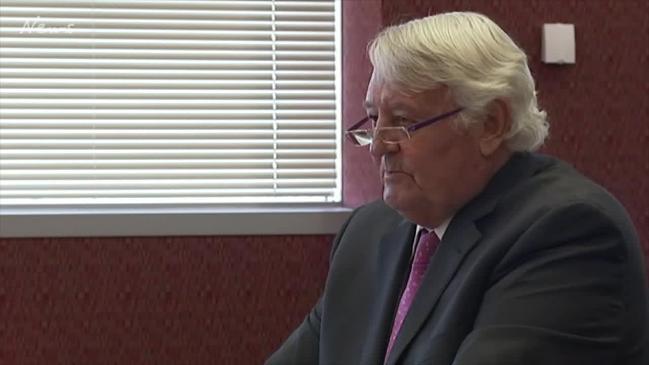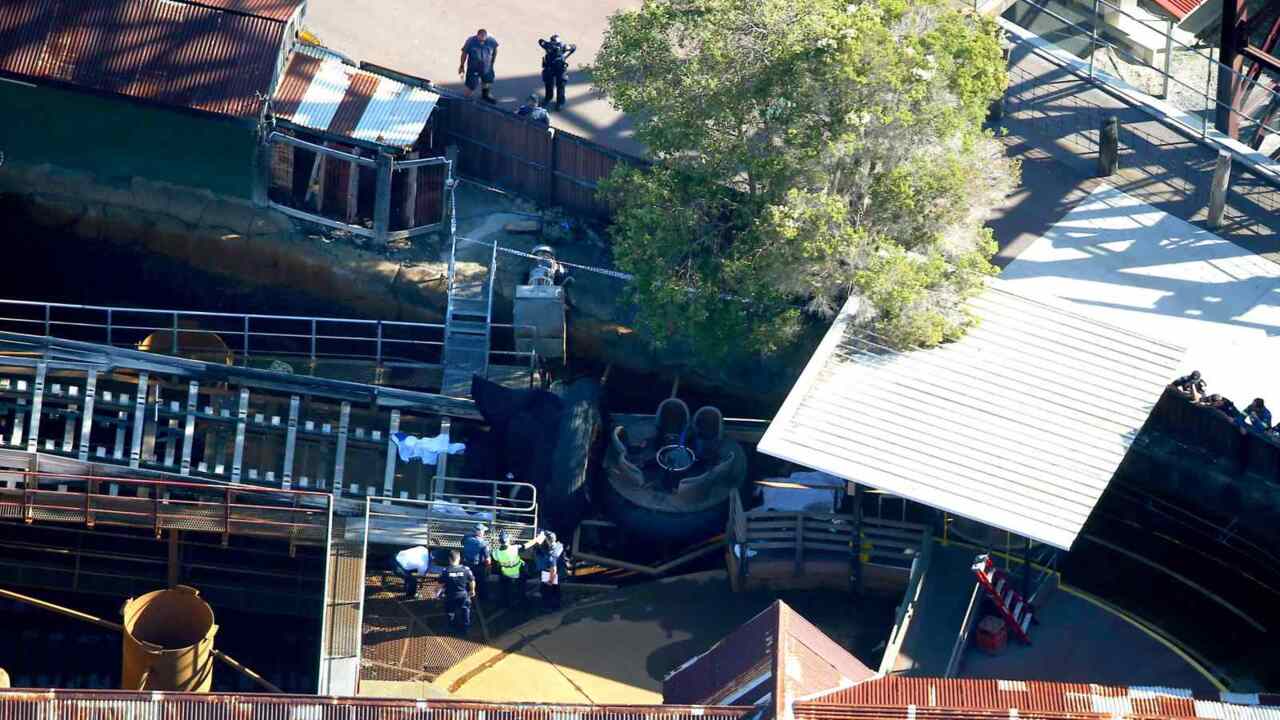Thunder River Rapids Ride: A history of problems
A RAFT on the Thunder River Rapids ride crashed and flipped upside down years before the fatal tragedy, with shaken staff sending out an internal email saying they “shuddered to think” of what could have happened if passengers were on board.

Crime & Justice
Don't miss out on the headlines from Crime & Justice. Followed categories will be added to My News.
- Dreamworld inquest: Tragedy was ‘preventable’
- Hero amid Dreamworld horror
- Dreamworld tragedy: Inquest begins
A RAFT on the Thunder River Rapids ride crashed and flipped upside down years before the fatal tragedy, with shaken staff sending out an internal email saying they “shuddered to think” of what could have happened if passengers were on board.
Kate Goodchild, Luke Dorsett, Roozi Araghi and Cindy Low were killed on Dreamworld’s family-friendly rapids ride after their raft flipped on October 25, 2016.
During an inquest into their deaths, southeastern Coroner James McDougall heard shocking details of an incident that occurred on the ride in January 2001 that was reminiscent of what happened on day of the tragedy.
The court heard two stationary rafts banked up at the unload area of the ride before three rafts came off the conveyor and collided.
One of them flipped, the inquest was told, but there was no one on the ride.
After the incident, emails were sent between rattled staff where they said: “I shudder when I think if there had been guests on the ride,” the inquest heard yesterday.
These emails will be discussed further throughout the inquest.

During his opening address, counsel assisting the coroner, Ken Fleming QC, said there had “sadly” been past incidents on the ride, including the 2001 event.
The 2001 incident was reported to Workplace Health and Safety, but written off as “operator error”, the inquest was told. Unlike the fatal ride, the incident in 2001 didn’t involve any change to the water-level.
Then three years later, a patron was thrown from one of the rafts into the water, the inquest heard.
But there was no change in the design of the ride after the incident in 2004.
Detective Sergeant Nicola Brown, who led the criminal investigation into the fatal tragedy, said while staff were trained to operate the rides there was no “drill training” to simulate emergency situations. Several days before the accident, on October 19, 2016, the south pump on the ride, that caused the water level to drop days later, tripped.
Det-Sgt Brown said she believed the accident could have been prevented.
“We could say what if, what if, what if all day long … there are things that had they not been there it would have prevented the accident,” Det-Sgt Brown said.
“Take one of those things away and it can’t have happened.” Staff did not raise concerns about the Thunder River Rapids ride with management, despite the incidents, the inquest heard.
WOODEN PLANKS REMOVAL EXAMINED
FOUR people died on the Thunder River Rapids ride after wooden planks were removed from the ride exposing the dangerous conveyor belt beneath the water.
A modification made sometime in the late-1980s or early-1990s, was yesterday considered during the inquest into the deaths of Kate Goodchild, Luke Dorsett, Roozi Araghi and Cindy Low, as a factor that could have led to their deaths.
The group were killed on Dreamworld’s family-friendly rapids ride in October 25, 2016.
The inquest, being held at the Southport Courthouse, yesterday heard full-length wooden planks that covered the conveyor belt on the ride were shortened and removed decades before the fatal incident.
This modification, which was never documented, stopped rafts from slipping, but created gaps above the conveyor belt to fall through.
Forensic crash investigator Sen-Constable Steven Cornish said: “Two out of every three planks were removed from the centre.”
He told the inquest staff said the planks were removed to “stop the slipping of the rafts” travelling through the ride.
Sen-Constable Cornish said some planks had also become bowed and could have caught on to the back of the rafts, potentially being a factor that led to the deaths.
“There was damage to some of the wood planks,” Sen-Constable Cornish said. “There was debris wedged within the planks.” When asked if the fatal accident could have been foreseen, Sen-Constable Cornish told the inquest: “The potential for that to happen was always there.”
MARKER FOR WATER LEVEL WAS BY ‘SCUM LINE”
THE only way operators could judge the water level on the Dreamworld ride that killed four people in 2016 was by a “scum line” left on the side of the wall.
Cindy Low, Kate Goodchild, her brother Luke Dorsett and his partner Roozi Araghi died when the Thunder River Rapids ride malfunctioned in October 2016.
A pump error caused the water level in the ride to drop quickly and significantly.
An inquest into their deaths, which yesterday began at the Southport Courthouse, heard there was no automatic cut-off feature on the ride when pumps stopped working.
Operators relied “simply on a scum line” rather than a ruler or an indicator to tell the water level was no longer at a “functional level” the inquest heard during cross-examination by barrister Matthew Hickey, for Cindy Low’s family.
Forensic Crash Unit Senior Constable Steven Cornish later told the inquest he believed the main problem with the ride was that there was not an “automatic shut down” when the water level got too low.
“You have operators there with conflicting roles and access to some buttons to stop things and not others and permissions to be sought from something to act in an emergency … (the ride) severely lacks an amount of automation…,” he said.
The court heard the only reason ride operator Courtney Williams realised there was a malfunction with the ride was that she saw the water level was below the scum line.
The inquest continues today.

TIMELINE: THE HISTORY OF THE THUNDER RIVER RAPIDS RIDE
REMOVED PLANKS
In 1980s or early 1990s, full-length wooden planks that covered the ride conveyer belt were shortened and some were removed, creating gaps to fall through.
THE RAFT FLIP
In 2001, a raft flips and staff email each other saying they “shudder to think” what could have happened if someone was on the ride.
THROWN INTO WATER
On October 7, 2004, there is a collision of two rafts and a theme park guest is thrown into the water. There no change in the design of the ride.
SAFETY AUDITS
In 2006, a safety audit of the ride recommends that a clearly labelled single stop button be installed. The ride remains unchanged.
POOR RATING
In 2016 a safety audit gives Dreamworld a rating of 41.7 per cent. A pass mark is 75 per cent.
DON’T PUSH THIS BUTTON
Five days before the tragedy, a memo is circulated to staff “dissuading” them from pressing a two-second emergency stop button. Pressing the button would have shut off the ride and prevented tragedy.
‘EARTH’ FAILURE
On October 19, 2016, the south pump on the ride experiences an “earth failure”. The pump was reset.
FIRST FAILURE
At 11.50am on October 25, 2016, the day of the fatal accident, the south pump experiences another “earth failure” again. Engineers reset the pump and the ride continues.
SECOND FAILURE
At 1.09pm the south pump fails again. The ride is stopped and engineers once again reset the pump but this is not documented.
FATAL FAILURE
At 2.03pm the south pump fails a third time. The usual procedure at Dreamworld is to shut a ride if it malfunctions three times in one day.
WATER DROPS
At 2.04pm on October 19, 2016, a raft becomes stuck on the conveyor because the water level has dropped on the ride.
CALLS FOR HELP
Ride operator Courtney Williams at the ride’s unloading area. She sees the water level dropping and signals there has been an operational problem. The noise from the pumps makes it hard to communicate.
CONFUSION
Ride operator Peter Nemeth is at the control centre near the start of the ride. The inquest heard during the “moment of stress” he wasn’t sure which button to press to stop the ride.
TRAGEDY
The raft carrying Kate Goodchild, Luke Dorsett, Roozi Araghi, Cindy Low and two children hits the first raft. Their raft flips and Ms Williams pulls Ms Low’s 10-year-old son Kieran to safety before the four adult victims are thrown into the water and killed instantly.


